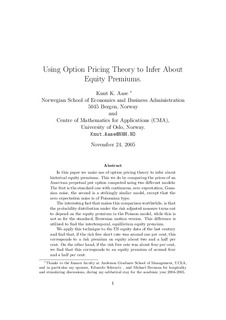Using option pricing theory to infer about equity premiums
Working paper
Permanent lenke
http://hdl.handle.net/11250/163597Utgivelsesdato
2005-11Metadata
Vis full innførselSamlinger
- Discussion papers (FOR) [566]
Sammendrag
In this paper we make use of option pricing theory to infer about historical equity premiums. This we do by comparing the prices of an American perpetual put option computed using two different models: The first is the standard one with continuous, zero expectation, Gaussian noise, the second is a strikingly similar model, except that the zero expectation noise is of Poissonian type. The interesting fact that makes this comparison worthwhile, is that the probability distribution under the risk adjusted measure turns out to depend on the equity premium in the Poisson model, while this is not so for the standard, Brownian motion version. This difference is utilized to find the intertemporal, equilibrium equity premium. We apply this technique to the US equity data of the last century and find that, if the risk free short rate was around one per cent, this corresponds to a risk premium on equity about two and a half per cent. On the other hand, if the risk free rate was about four per cent, we find that this corresponds to an equity premium of around four and a half per cent. The advantage with our approach is that we only need equity data and option pricing theory, no consumption data was necessary to arrive at these conclusions. We round off the paper by investigating if the procedure also works for incomplete models.
Utgiver
Norwegian School of Economics and Business Administration. Department of Finance and Management ScienceSerie
Discussion paper2005:11
